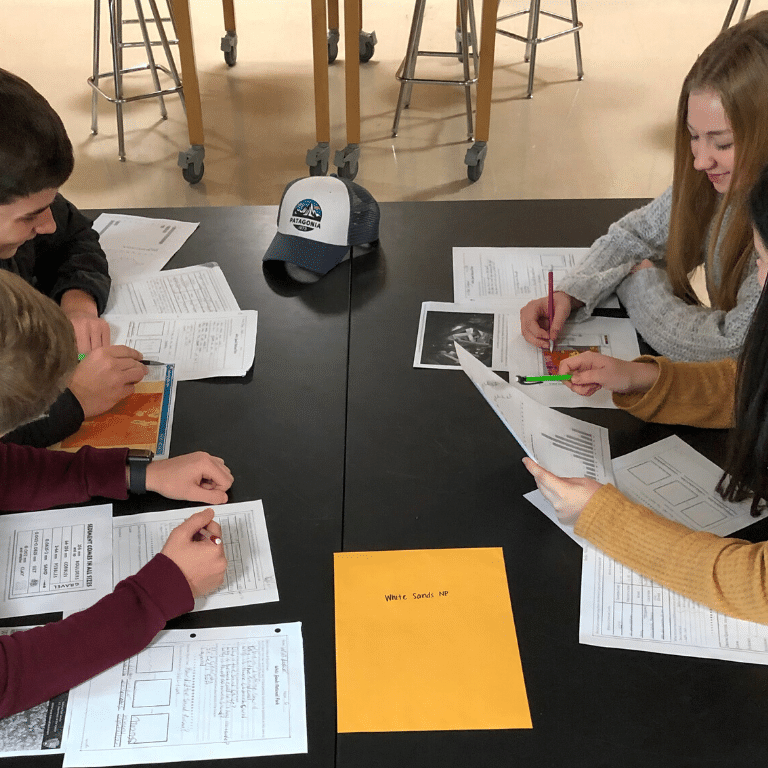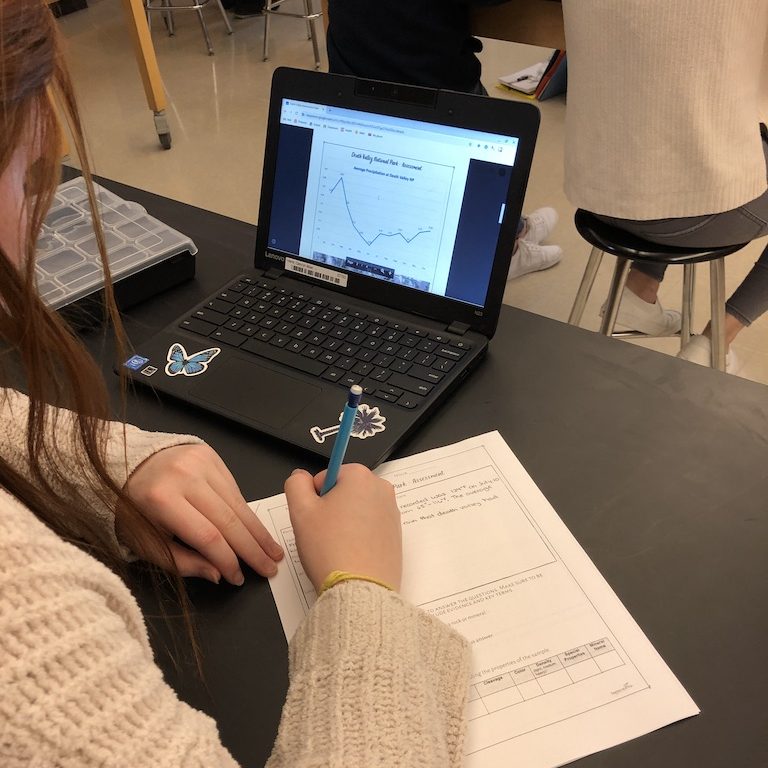Using 5E Model to Write NGSS Aligned Lesson Plans

Backstory of Writing NGSS Aligned Lesson Plans
Next Generation Science Standards are not just an updated set of standards. NGSS is a transformation in how we teach and how our students learn. To fully embrace the transformation, we need to change how we write NGSS aligned lesson plans and units.
I highly recommend creating NGSS aligned storylines to provide the overall structure and flow to the unit. The lesson plan writing strategy outlined in this article is used within the storyline.
Throughout this article, lesson means a complete learning sequence, not necessarily one class period. Some lessons could take a couple of class periods or maybe even an entire week. Additionally, the length of a class period is established by individual school districts; lesson as a learning sequence is common amongst all teachers.
Writing an NGSS Lesson Plan
NGSS aligned lesson plans will incorporate all three dimensions of NGSS. Science and Engineering Practices are what students are doing. Crosscutting concepts are how students are thinking and processing information. Disciplinary Core Ideas are what students are learning.
Determine Lesson Goal
Keep it simple. This is the learning goal for the learning sequence, not an entire unit. Refer to the NGSS Performance Expectation (PE) Evidence Statements (click here for a website assist) for inspiration when selecting a grade-appropriate, aligned learning goal.
At the bottom of the Evidence Statement document, the observable features of the student performance can guide your lesson objective. Your goal should be observable and measurable.
If you’re following the NGSS aligned storyline structure to create a unit, use one of students’ driving questions to guide the lesson planning process. Determining the learning objective from the Evidence Statement and/or driving questions will establish how you intend to evaluate students at the end of the lesson.
Utilize the 5E Model to Write an NGSS Aligned Lesson Plan
Engage → Explore → Explain → Elaborate → Evaluate
Engage

The first stage in the 5E Lesson Model, Engage, is much more than just a hook.
This is the opportunity for students to have a shared experience that can be referenced during this and future learning sequences. Students can ask questions about how a phenomenon is occurring or how to solve a problem.
This is also the teacher’s opportunity to gain more clarity about students’ prior knowledge and potential misconceptions. Although, we’re not going to correct them yet.
You are going to select a phenomenon that gets students asking questions, but doesn’t answer their questions. Video clips, observations of images, and graphs/data sets are all good examples of mediums to present phenomena.
Allow students time to ask questions and brainstorm hypotheses during this stage. You are building their interest through their engagement with content.
Try not to get too bogged down searching for the “perfect” phenomenon or problem. It doesn’t have to be perfect as long as the phenomenon incites wonder and encourages students to ask questions.
Explore

Use the Science and Engineering Practice(s) and Crosscutting Concept(s) associated with your chosen PE to guide your Explore activity. Design a learning activity that matches what students should be doing, and how students should be observing and making connections.
At this Explore phase, design an activity that exposes students to a broader understanding of a science concept. It doesn’t have to be exactly the lesson’s end goal, yet.
Something else here to describe the explore phase.
Teacher, your role during the Explore phase is to facilitate more than teach. Give students space and time to puzzle through what they’re learning. Redirect as needed by asking clarifying and probing questions.
Explain

The observations and connections that students began to make during the Engage and Explore phase will come to light during the Explain phase.
During the Explain phase, the teacher provides students with resources and content information to support students’ explanations. In turn, students should use new scientific terms to explain what they observed/discovered during the Engage and Explore phases.
Now that students have engaged with the content, it is time to provide them with scientific terminology to describe what they have observed.
This is also the time to provide more explicit instruction for students about the science concepts they observed. Research supports that students learn more efficiently when their exploration is supported with direct instruction.
Students also need an opportunity to share their understandings individually, with peers, or small groups during the Explore phase. Peers can provide feedback to enhance clarity and accuracy of students’ explanations.
At this point, students are expected to use appropriate vocabulary terms within their explanations.
Elaborate

Students gain deeper understandings on the science concept by applying their new understandings, skills, thought process(es), and vocabulary to similar, but novel scenarios.
Revisit the learning goal and PE from established at the beginning of lesson development. Then, take note of the associated Science and Engineering Practice(s) and Crosscutting Concept(s) from the Explore phase.
Recall that the Science and Engineering Practices are what students will be doing. The Crosscutting Concepts are how students are thinking, processing, and connecting information.
Use the Science and Engineering Practice(s) and Crosscutting Concept(s) associated with your chosen PE to guide your Elaborate activity. Design a learning activity that matches what students should be doing, and how students should be observing and making connections. This activity should deepen students’ connection of the content from the previous phases – Engage, Explore, and Explain.
Place an emphasis on students using the proper vocabulary, providing evidence in their explanations, and being able to communicate their findings to others.
Evaluate

When developing the 5E Lesson we made sure to incorporate all three-dimensions of NGSS. Therefore, the assessment should also be three-dimensional. What does that mean?
We’re not limiting evaluations to what students have learned, but also including the application of practices, and strategies for scientific thinking. That is a three-dimensional assessment.
Return to your learning goal established at the beginning of the lesson planning process. This is your guide to what and how to assess students’ understanding of content and application.
First, determine what type of assessment you will use to evaluate students’ learning. Think beyond a traditional quiz.
Assessment Ideas
- Developing a model – Or present partial models for students to critique/improve
- Presentations – Screencastify recordings are great for these!
- Lab skills assessment – Students demonstrate application of lab skills and draw conclusions
- Graphic organizer – Students show connections between concepts and processes
- Claim, Evidence, Reasoning – Great for engaging in argument from evidence
- Student peer/self-assessments with a rubric – Grade themselves or each other
- Open-ended questions – Students must use evidence to support their answers
Use the science and engineering practice(s) and the crosscutting concept(s) you outlined through the 5E Lesson Model to guide your assessment plan.
Make sure that your assessment requires students to demonstrate more than just the content they learned, but also requires an application of a science and engineering practice and thinking like a scientist.
Myths about 5E Model
Entire 5E model is completed in one day
Just no. How could you feasibly fit all 5 stages into one 45-50 minute class period? Even if you had a block schedule with 90 minutes you would be hard pressed to give each phase its due diligence in that amount of time. Ideally a complete 5E Cycle would take 2-3 weeks for each learning sequence. That’s what the research supports. And I’m here for it. We’re science teachers and we want our teaching decisions to be driven by research. However, we’re also teachers who are limited by the number of days we teach, students in and out for various activities, school breaks, testing, etc. We don’t always get the two weeks, but we’ll give it our best.
Stages can go in any order
Engage, Explore, Explain, Elaborate, Evaluate. The 5E Cycle was developed in 1987, so research is available that supports the effectiveness of the 5E Lesson Model. The research supports the 5E Lessons Model is most effective when the phases are presented in this order. Engage must come before explore, explore before explain and so on.
5Es are linear
This is not to stay that each phase can only be introduced and completed once. In this challenge, we are completing each phase once and moving to the next, in a linear fashion. The reality is science is not linear and neither does our teaching/learning of science in the classroom. Engage, Explore, Explain, Explore, Explain, Elaborate. For now, we stick with the basics.
Explain is the spotlight for the teacher to do the explaining.
I used to think Explain was the part where we go to do our “Teaching as Telling.” Nope. This phase is for the students to explain their new understandings. I thought that because this is the phase where teachers are most involved with providing resources for clarification, scientific terms
5 Days to a 5E Challenge for $5
Let’s design your NGSS aligned 5E lesson!
The 5E strategy is the go-to structure to turn to when lesson planning and developing storyline investigations. This structure puts students in the driver seat of their learning. So, if you have students who seem disconnected or apathetic with the content – it’s time to write your lessons using the 5E strategy.
Who? Earth science teachers ready to create an engaging, rigorous NGSS aligned lesson.
What? We’ll follow the 5E lesson model development process to create three-dimensional learning opportunities for students to do science and think like scientists, while learning science.
When? January 27-31, 2025
These are the days I’m sending the emails…you can complete the daily action steps on your own schedule.
Where? Sign-up here and you’ll receive the workbook and each step of the challenge in your email.
Why? The 5E Lesson Model is the backbone to NGSS aligned lessons. Planning NGSS aligned lessons doesn’t need to be overwhelming. Learn this strategy and hit repeat.
Save for later. Pin it!

